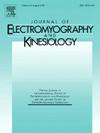基于U-Net的局部卷积时域分离模型,从肌电信号中实时识别运动单元。
IF 2.3
4区 医学
Q3 NEUROSCIENCES
引用次数: 0
摘要
本研究提出了一种基于U-Net的局部卷积时域模型,用于高密度表面肌电图(HD-sEMG)的实时分解。该模型将U-Net和包含部分卷积的分离块相结合,目的是在不进行预处理的情况下有效地识别运动单元(mu)。采用带神经支配脉冲序列(IPTs)标签的HD-sEMG信号对U-Net网络进行训练,并在滑动时间窗下选取120个采样点,对不同步长、噪声和模型结构的训练结果进行比较。基于U-Net的模型在模拟信号和实验信号下的识别精度分别大于94%和85%,比基于卷积神经网络(CNN)和时间卷积网络(TCN)的结构识别出更多的微信号。在步长为20的两类信号中,基于U-Net的模型的平均延迟仅为64 ms(窗口持续时间加上预测时间),并且可以推广到不同信噪比的新数据。该模型的效率明显高于gCKC等传统方法。同时,该模型与gCKC模型的准确率无显著差异。此外,验证了网络在不同步长滑动时间窗下的性能。实验结果表明,基于U-Net的模型为肌电信号的盲源分离(BSS)提供了一个有效的框架,扩展了肌电信号在神经交互中的应用。本文章由计算机程序翻译,如有差异,请以英文原文为准。
A U-Net based partial convolutional time-domain separation model to identify motor units from surface electromyographic signals in real time
This study proposed a U-Net based partial convolutional time-domain model for a real-time high-density surface electromyography (HD-sEMG) decomposition. The model combines U-Net and a separation block containing partial convolution, aiming to efficiently identify motor units (MUs) without preprocessing. The proposed U-Net based network was trained by the HD-sEMG signals with innervation pulse trains (IPTs) labels, and the results are compared between different step sizes, noises, and model structures under the sliding time window with 120 sampling points. The U-Net based model got an accuracy greater than 94 % under simulated signals and 85 % under experimental signals, and identified more MUs than the structures based on convolutional neural network (CNN) and temporal convolutional network (TCN). The average latency of the U-Net based model is only 64 ms (a window duration time plus the prediction time) under the step size 20 data in both types of signals, and can be generalized to new data at different signal-to-noise (SNR). The efficiency of the proposed model is significantly higher than traditional methods such as gCKC. Meanwhile, the accuracy of the proposed model was not significantly different from the gCKC. In addition, the performance of the network under different step sizes of the sliding time window was verified. The experimental results indicate that the U-Net based model provides an efficient framework for blind source separation (BSS) of EMG signals, expanding the application of EMG signals in neural interaction.
求助全文
通过发布文献求助,成功后即可免费获取论文全文。
去求助
来源期刊
CiteScore
4.70
自引率
8.00%
发文量
70
审稿时长
74 days
期刊介绍:
Journal of Electromyography & Kinesiology is the primary source for outstanding original articles on the study of human movement from muscle contraction via its motor units and sensory system to integrated motion through mechanical and electrical detection techniques.
As the official publication of the International Society of Electrophysiology and Kinesiology, the journal is dedicated to publishing the best work in all areas of electromyography and kinesiology, including: control of movement, muscle fatigue, muscle and nerve properties, joint biomechanics and electrical stimulation. Applications in rehabilitation, sports & exercise, motion analysis, ergonomics, alternative & complimentary medicine, measures of human performance and technical articles on electromyographic signal processing are welcome.

 求助内容:
求助内容: 应助结果提醒方式:
应助结果提醒方式:


